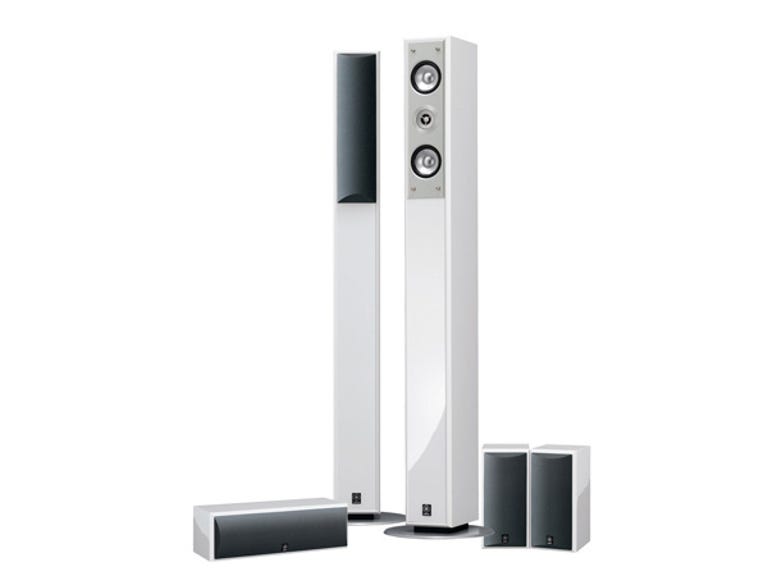 Why You Can Trust CNET
Why You Can Trust CNET Yamaha NS-F210 review: Yamaha NS-F210
Fast and exciting-sounding, Yamaha's 210 Series speakers are a bit of a mixed bag, thanks to a lightweight subwoofer.
Yamaha has long been known for its excellent range of A/V receivers and processors, and can pretty much lay claim to single-handedly pioneering surround sound in the early days. It was also a speaker force to reckoned with, but mainly in professional markets. Recently, the brand's been busy developing several domestic speaker ranges, one of which we have here — the 210 Series.
The Good
The Bad
The Bottom Line
Design and features
The 210 Series models are available separately (AU$799) or combined as a 5.1-channel surround system (AU$1706). It comprises the usual — slim main front towers, small NS-C210 centre speaker (AU$159), a pair of small NS-B210 surrounds (AU$299) and a slim NS-SW210 active subwoofer (AU$449).
High-gloss black or white are the shiny finishes, and at least in white (as our system came) you can't actually see the settled dust. The rather unassuming-looking NS-SW210 subwoofer is front ported, with a side-firing 160mm woofer and 100 watts of on-board amplification. Its controls are simply an on/off switch and a volume knob — that's it. All remaining 210 speakers share the same small 80mm aluminium cone bass/mid drivers and 22mm balanced dome tweeter.
It's a pleasant surprise to find a complete lack of any spring clip speaker terminals and proper 4mm binding posts all round. The collective slim cabinets mean that very little living room space is needed to accommodate the 210s, plus the NS-C210 centre and NS-B210 rears have keyholes for wall mounting. In the flesh, the look is deliberately modern, with the high-gloss finishes and slim lines designed to match the same look as current flat panel TVs.
The specs make for amplifier-friendly reading, and your typical midrange A/V receiver would be perfectly at home driving the 210s; we'd suggest that a model around the AU$1000 mark would be ideal; something like Yamaha's new RX-V571. We hooked them up to a slightly older Yamaha receiver using an HD BenQ projector for the visuals.
Performance
Stereo
Using the NS-F210 towers and the NS-SW210 for music duties, we found that the trio made some pleasant noises. Typical of metal cone drivers, the F210s sounded fast and highly detailed. Midrange clarity was excellent, which gave vocals, both male and female, excellent projection into the room. Soundstaging wasn't the broadest that we'd heard, but stereo imagery was particularly well focused and stable. Playing Raising Sand, the duet between Robert Plant and Alison Krauss, speed and immediacy in the mids and highs was obvious, and sounded very suitable to the bluegrass/rock infusion style. We had to crank the subwoofer's volume control up a fair bit for its presence to be felt, as the F210 towers generate hardly any real bass on their own — which is not surprising, given the tiny drivers and slim cabinets.
Surround
Collectively is where the 210 system comes together best. Despite its small size, the NS-C210 centre speaker lends ample weight and definition to voices and other centrally placed effects, and at this end of the room, the mains and centre produced a united front, with good integration and soundstaging ability. At the other end, the NS-B210 surrounds added plenty of rear ambience, and while we'd have liked them to be a little less directional, channel steering and dispersion was generally impressive, given the speakers' size and conventional two-way design. As far as the five surround speakers are concerned, theirs is a harmonious tonal collaboration, and we liked the fast, attacking and detailed soundfields that the 210s generated.
We found it best to set the front, centre and surround speakers as "small" on the A/V receiver's set-up, so that the subwoofer handles more of the upper-bass frequencies. You're best to set the crossover frequency, too, as there's no manual adjustment on the sub — we set it at 80Hz. We like Yamaha's active subwoofers, but found this one to be a little too lean to do big movie soundtracks full justice. It's far better than the passive subs that accompany most home-theatre-in-a-box systems, but it still can't dish up the sort of bass depth that loosens window panes.
Conclusion
Fast and exciting-sounding, Yamaha's 210 Series speakers are a bit of a mixed bag, thanks to a lightweight subwoofer. If gargantuan bass isn't what you're after, then this system will give any room a lively 5.1-channel serving of both music and movie soundtracks.
